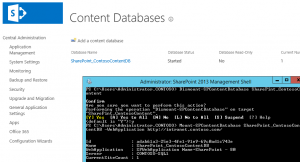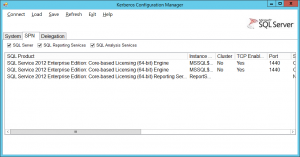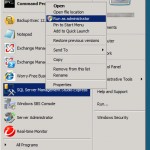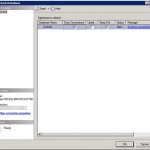 So I’ve been toying with SharePoint 2013 in my lab at home, doing the install and configuration at the moment, setting up my first Site after the initial configuration but noticed that I made a typo in the Database name. So how do I go about fixing or renaming that database in SharePoint and in SQL Server.
So I’ve been toying with SharePoint 2013 in my lab at home, doing the install and configuration at the moment, setting up my first Site after the initial configuration but noticed that I made a typo in the Database name. So how do I go about fixing or renaming that database in SharePoint and in SQL Server.
First thing first is we need to know the name of the Content database, in my case it is easy, because we only have one and I can easily see the spelling mistake I made. But if you need to work out the name of the Database, you can look in Application Management > Manage Content Databases and click on the Site Collection you are after; alternatively you can use SharePoint’s management shell and issue the following two cmdlet’s;
Get-SPWebApplication | Select-Object Url, ContentDatabases | Format-List
What sites are using this content database;
Get-SPContentDatabase | Where-Object {$_.Name -eq "SharePint_ContosoContent"} | Select-Object Sites | Format-List
So now we know the name of our content database, we need dismount it before we can rename it in SQL Server. To dismount use the following cmdlet;
Dismount-SPContentDatabase SharePint_ContosoContent
Now the database is ready to rename. Open up SQL Management Studio and connect to your Database Server hosting SharePoint. Now usually when you go to rename a database you will get an error message stating that the database is in use. To get around that we turn our database into Single User mode, rename it and then set it back to multi user mode with the following SQL snippet.
USER Master
-- Set to Single User to prevent unable to lock out
ALTER DATABASE SharePint_ContosoContentDB SET SINGLE_USER WITH ROLLBACK IMMEDIATE
-- Rename Database
ALTER DATABASE SharePint_ContosoContentDB MODIFY NAME = [SharePoint_ContosoContentDB]
-- Set back to multi user for production use
ALTER DATABASE SharePoint_ContosoContentDB SET MULTI_USER
Now once we have renamed the database on our SQL Server, it is time to mount it back onto SharePoint, we do that by issuing the following PowerShell on our SharePoint server
Mount-SPContentDatabase SharePoint_ContosoContentDB -WebApplication http://intranet.contoso.com/
And there you have it, renaming a SharePoint content database if you make a typo like me.
Share this post with others:
 I had a customer call up and explain their Power BI reports had stopped working, they’re not managed so after working a few things out we got to work and jumped into their Datawarehouse environment in AWS. After a quick look we could see that their RDS SQL Server instance had TLS turned on and that no one had managed or bothered to rotate the certificate which had now expired. This is a very quick and painless process (since it’s a managed instance) and simply requires a reboot. Once loaded, refreshing a report would result in an error of Something went wrong, and looking in the details we could see The certificate chain was issued by an authority that is not trusted.
I had a customer call up and explain their Power BI reports had stopped working, they’re not managed so after working a few things out we got to work and jumped into their Datawarehouse environment in AWS. After a quick look we could see that their RDS SQL Server instance had TLS turned on and that no one had managed or bothered to rotate the certificate which had now expired. This is a very quick and painless process (since it’s a managed instance) and simply requires a reboot. Once loaded, refreshing a report would result in an error of Something went wrong, and looking in the details we could see The certificate chain was issued by an authority that is not trusted.  You also need to ensure to load the AWS RDS Root certificates onto their Power BI Gateway and Reporting server, downloading them from AWS here and then loading them into the trusted certificate authority in the Windows Certificate store. Once done, we could see reports refreshing and pulling data as expected.
You also need to ensure to load the AWS RDS Root certificates onto their Power BI Gateway and Reporting server, downloading them from AWS here and then loading them into the trusted certificate authority in the Windows Certificate store. Once done, we could see reports refreshing and pulling data as expected.


